Behavioral Ecology - Exam 2
1/61
Earn XP
Description and Tags
ZOO425 Exam 2 - Spring 2025
Name | Mastery | Learn | Test | Matching | Spaced |
|---|
No study sessions yet.
62 Terms
predator-prey interaction sequence

way to escape predator-prey sequence at 1
activity of timing, spatial incongruence, both
way to escape predator-prey sequence at 2
vigilance (ex. sleeping ducks brain activity based on group location)
way to escape predator-prey sequence at 3
maximize cripsis or change spatial location (seek refuge)
way to escape predator-prey sequence at 4
convince predator of low quality or high capture costs
way to escape predator-prey sequence at 5
initiate flight (flee)
way to escape predator-prey sequence at 6
active defense, be distasteful, play dead (all last stops)
life-dinner principle
prey are running for their life, predator running for their next meal
higher cost for prey, so evolution works stronger on prey
flight initiation distance
distance from predator where flight is initiated depends on distance to refuge, prey experience, and predator effects
combining predation and MVT
patch quality influenced by predation risk determines energy yield in patches
how long in a patch is influenced by predation risk
giving up density equation
GUD = P + C + MOC
information
reduces ambiguity regarding the state of the environment, clarifies risk
cue
some component of the environment that can be perceived by a focal organism (by any sensory modality) and provides information
direct cue
produced by the predator or the act of predation
indirect cue
associated with predation risk, but not produced by the predator or the act of predation, typically raises or lowers risk no matter whether the predator is there or not (ex. time of day, presence of refuge)
predator facilitation
one predator benefits from anti-predator behavior from another predator, cost of risk-adversion
quality of information depends on
quality - how much it disambiguates
cost of gathering information - time, energy, risk, MOC
discrimination - ease and costs or benefits of determining different states
environmental change
error management theory (smoke detector principle)
there are two ways to be wrong, err towards the least costly way
false-postive
assumes risky when actually safe, costs of unnecessary defense
false-negative
assumes safe when actually risky, costs of forced attack defense
decision threshold
where the organism decides to accept false-positives or false-negatives
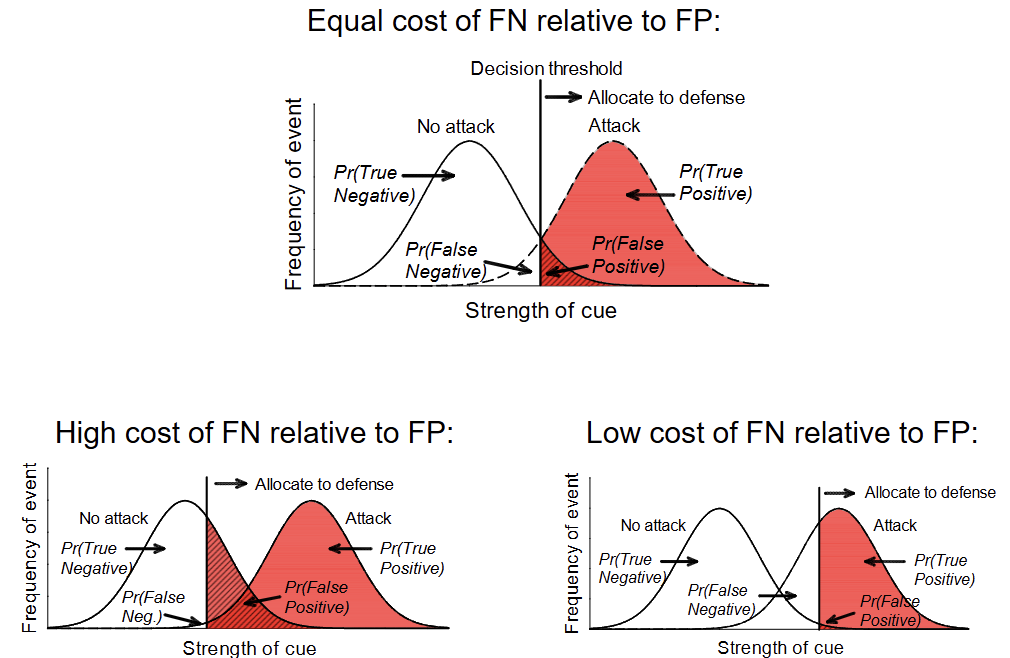
consumptive effects (CEs)
effects created by predation (by eating the prey)
non-consumptive effects (NCEs)
effects created by the risk of predation
risk allocation theory
prey in acute risk environments are more responsive to pulses of risk than prey in chronically risky environments
depends on background and duration of the cue
must eventually accept some level of risk due to the cost of safety becoming too high
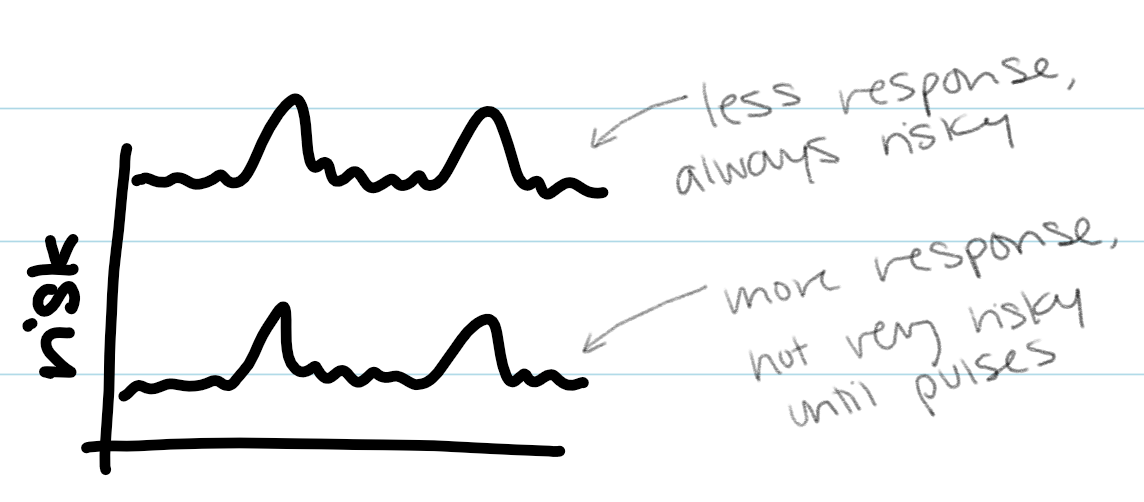
induced defense
a defense mechanism induced by the environment
typically morphological (ex. daphnia shape in presence of fish), chemical (ex. plants predation and MeJA exposure), or behavioral
crypsis
prey defense where prey matches the background
avoids detection
prey must choose correct background
masquerade
prey defense where prey is mistaken for background
avoids identification
requires predator experience being not interested in the background (ex. chickens and sticks)
aposematic (warning colors)
prey want to be detected and identified as a threat
identified as a threat
predator must have innate or learned recognition
innate more likely in high risk situations
mullerian mimicry
two dangerous species mimic each other
both species benefit
batesian mimicry
a harmless species mimics a dangerous one
reduces protective value of dangerous one unless mimic is very rare or the dangerous one is very dangerous
aggressive mimicry
a dangerous species mimics a harmless one
arms race
a strong reciprocal selection, coevolution with natural enemies and what they attack
needs extreme interactions between species
less strong with asymmetric or opposing selection
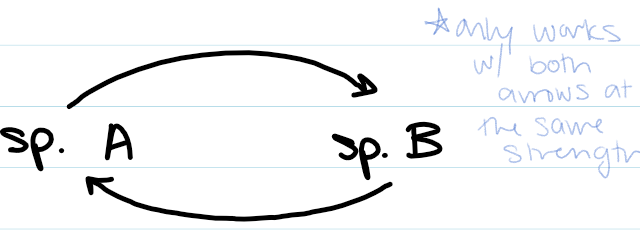
asymmetric selection
selection that is stronger in one species than another (ex. life-dinner principle)
opposing selection
selection for one thing causes a decrease of fitness for another
probability of arms race
predator-prey < host-parasite < host-pathogen
hosts change behaviors
parasitoids
ecology of disgust
why things provoke disgust may be due to innate parasite avoidance
parasites change host behaviors
ex. increased predation risk to move parasites to next host species
interspecific competition
competition between different species
intraspecific competition
competition within species
exploitation competition
one competitor uses a resource better
interference competition
one competitor prevents another species from using or accessing a resource
patch
a spatial subset of a habitat that is treated as a single homogenous unit by the behavior of the individual
depends on the individual’s use of a habitat subset
habitat
a spatially bounded area with a subset of physical and biotic conditions within which the density of interaction individuals, and at least one of the parameters of population growth is different than adjacent habitats
habitat selection
the process whereby individuals preferentially use or occupy a non-random set of available habitats
Ideal Free Distribution (IFD)
a model of exploitive, intraspecific competition
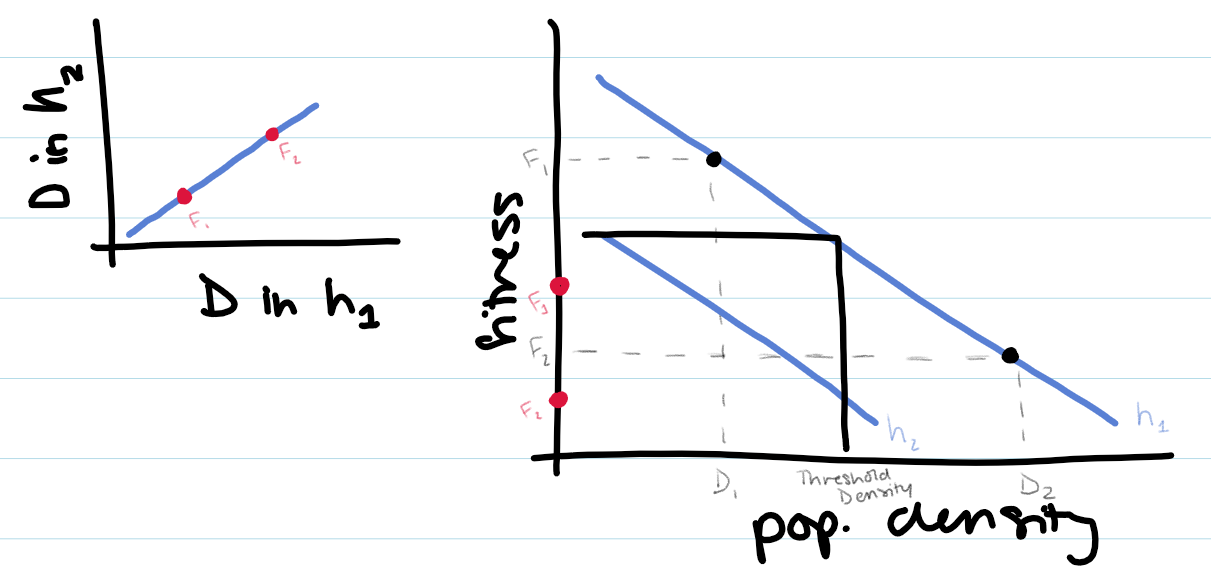
IFD assumptions
individuals are ideal (have perfect knowledge of available habitats) and free (have no constraint on selection the optimal habitat) and fitness is negatively related to density (competition decreases fitness)
IFD predictions
fitness is equal among habitats if the density is such that both habitats are being used
density differs, but fitness doesn’t
F1 = F2 but D1 ≠ D2
correlation between density and quality
acute indicators of each other
higher density = higher habitat quality
Aphid galls on leaves
same average number of aphids per gull with a different number of gulls
however, within a leaf the gulls interfere with placement on a leaf
not free
whether IDF applies may depend on the scale
Isodars
when D1 and D2 are based on equal fitness, you can predict fitness from the densities or predict the densities based on equal fitness (ex. pike)
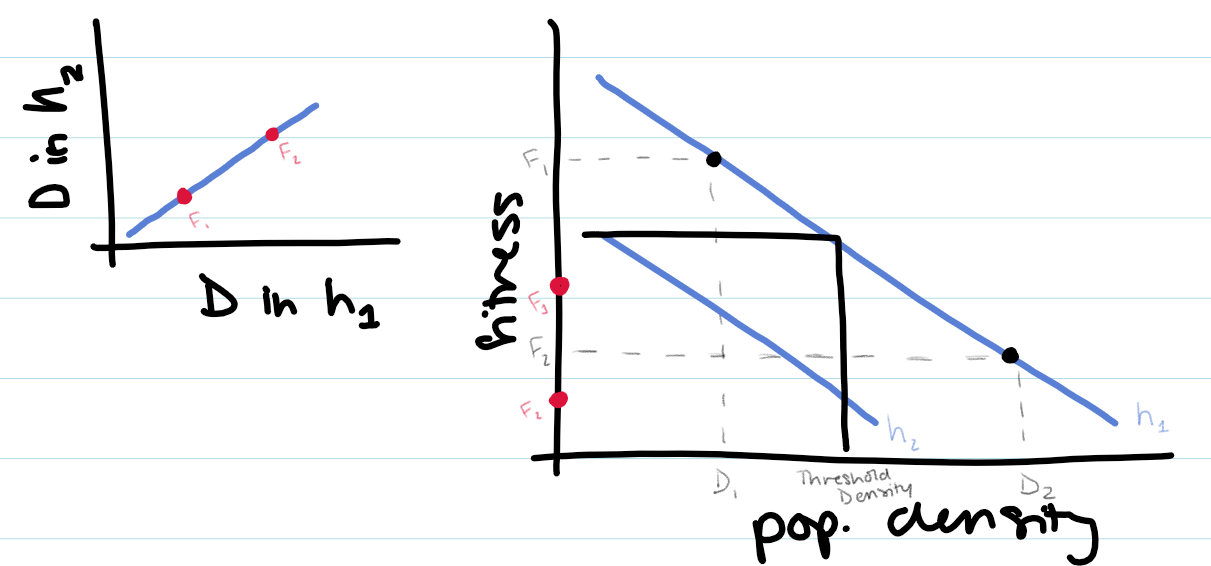
territoriality
the economic defendability of a resource, depends on the environment
territoriality requirements
many intruders, has resources distributed across space and time in clusters of high and low abundances
signs of territoriality
non-overlapping space use held by an individual or group of individuals that can be always held or seasonally held
costs and benefits of territoriality
benefits - sole access to a resource
costs - defense (time and energy)
Ideal Despotic Distribution
IFD where the individuals are not free
territoriality stops free choice of habitat
cannot make IDF assumptions
determining IFD or IDD
must measure whether a population is free or not
measure fitness between populations, territoriality, demography (age, size reproductive status)
ex. higher quality habitat held by dominant individuals who are older/larger/highly reproductive
source-sink population
organisms from the source migrate to the sink, what happens to the populations depends on the state of the source, sink, and the ability to migrate between them
source: lambda < 1 (increasing population growth)
sink: lambda > 1 (declining population growth)
source-sink populations with territoriality
ex. source is territorial and only the very best get good quality territory and pushes others out to the sink
individuals not free! (cannot choose to go back to the sink, forced out) - IFD assumptions do not apply
population of source < population of sink
must gain more information to determined whether it is a source or sink population
costs and benefits of group living
depends on the environment and group/social structures and can change in space and time (ex. information sharing or reproduction as a cost or benefit)
benefits - predation risk (vigilance, dilution, predator defense), environmental stress, mate location, social or shared information
costs - competition (resource of reproductive interference), disease or paratisms, social or shared information
Lima and Dill 1990
meta-analysis on predation risk trade-offs and decision making when exposed to a CE, highlighted predation influence on ODM and MVT
Morris 2006
Ideal Free Home Theory and pike
Pravosudov 2009
chickadee cache location and ability to recognize pilferer species